There is a further twist to this tale. Recently Zecharia Sitchin posted an article that described a French magazine article in the February 2003 issue of 'Science & Vie' (5). He complained that an astronomer in France had provided information for the magazine article about a possible tenth planet in the Solar system with an eccentric orbit. The ideas expressed in the article were very similar to Sitchin's 12th Planet Theory, even down to the image used (below). Sitchin cried foul, but to no avail. It was presumed by all concerned that the esteemed astronomer could not possibly have been influenced by zany Zecharia Sitchin, and that therefore there was no case to answer (6).
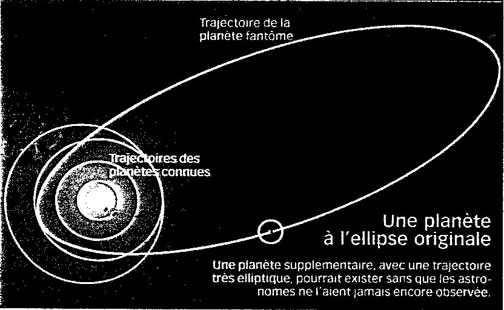
Well, that astronomer is none other than Alessandro Morbidelli, one of the co-authors of the paper I have just been discussing. His 'big idea' in the academic paper, due for publication in November 2004, is that the Solar system may have picked up a huge amount of planetesimal material from a passing low mass star or brown dwarf. Such an interaction would be very much in keeping with Zecharia Sitchin's own theories, would it not?
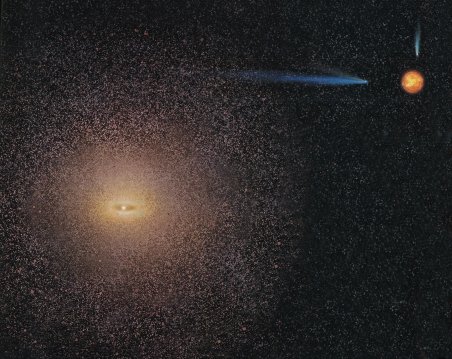
Image credit: An artist's rendering of how the Sun's Oort Cloud might be affected by the future close transit of Gliese 710 - Sic-Am
with thanks to J/J/K
One final point to note from Morbidelli and Levison's intriguing paper is their interest in the capture process itself, which is to be the subject of further research:
"A detailed exploration of the capture process, which might also be relevant for different problems like the origin of the Oort cloud or the origin of the irregular satellites of the giant planets, will be the subject of a forthcoming paper." (2)
These guys are clearly thinking big. Perhaps other astronomers should take note...
The Origin of Sedna
It's become apparent to me recently that the scholarly world of astronomy is shifting its position on the origins of the solar system. One of the big changes is an acceptance that the Sun started life as part of a cluster of young stars, perhaps with some of them the same size as the Sun, more probably with lower mass stars or brown dwarfs. This scenario has become acceptable because the outer solar system has recently been giving up some of its secrets, and the data is in keeping with the intervention of an outside body.
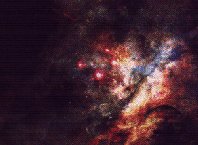
The reason? Several Trans-Neptunian Objects, including 2000 CR105 and Sedna (2003 VB12) orbit the Sun along eccentric paths whose closest point to the Sun is beyond the influence of Neptune. This means that other factors placed these 'extended scattered disc objects' along their current, highly inclined trajectories. The solution is no small matter either, and several groups of scientists have been modelling various scenarios to help explain these unexpected anomalies.

The difficulty they face is juggling the need to theoretically reproduce Sedna's orbit, yet not produce a huge mass of other scattered disc objects (the population of which is known to be low). This is no easy task. During the summer the New Scientist reported the findings of the astronomers Alessandro Morbidelli, of the Observatoire de la Côte d'Azur, and Harold Levison of Boulder, Colorado, USA.
"Sedna's orbit is so extreme researchers say it could not have formed simply from the gravitational kicks of the giant planets, which are responsible for the eccentric orbits of the comets and Pluto. "If this thing was scattered out by a planet, something else had to change the orbit, something we don't see," says study co-author Hal Levison "That's why Sedna and 2000 CR105 [the next most-distant object] are so cool. They tell us something was different back when they formed." (1)
The co-authors of the paper examined five scenarios using computer modelling:
-
The passage of Neptune through an high-eccentricity phase
-
The past existence of massive planetary embryos in the Edgeworth-Kuiper belt or the Scattered Disc
-
The existence of a massive body beyond Neptune during the early solar system (Planet X scenario)
-
A close stellar passage
-
The capture of extra-solar planetessimals from low mass stars or brown dwarfs encountering the Sun.
The computer simulations of the early solar system when each of these scenarios was considered enabled the two researchers to rule out possibilities 1, 2 and, importantly, 3 ("An Earth-mass planet at the edge of the Kuiper Belt simply cannot transport objects from a nearly circular orbit to large semi-major axes in the age of the Solar system without first handing them off to Neptune" (2)).
Morbidelli and Levison found a good fit with number 4, but noted that a prior encounter with a passing star might be ruled out in the future if the population of the extended scattered disc "proved to be more massive than a few tenths of an Earth mass" (2).
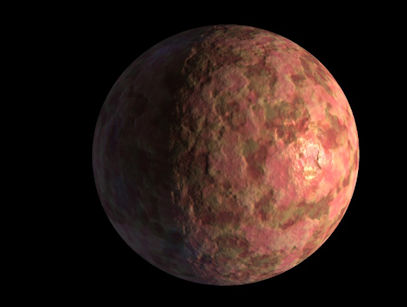
Image credit: NASA
We don't know whether that is the case at the moment because the observational ability to pick up such distance objects is on the edge of the technological capability available to astronomers. But we should know within a few years if many more objects like 2000 CR105 and Sedna are discovered. In that case (which I personally think is likely), the fifth scenario becomes a real possibility. The computer images below were derived from simulations carried out by Scott Kenyon of the Smithsonian Astrophysical Observatory and Benjamin Bromley of the University of Utah (3):
"Kenyon and Bromley suggest that the near-collision occurred when our Sun was at least 30 million years old, and probably no more than 200 million years old. A fly-by distance of 150-200 A.U. would be close enough to disrupt the outer Kuiper Belt without affecting the inner planets.
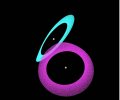
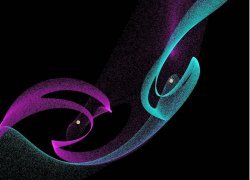

"According to the simulations, the passing star's gravity would sweep clear the outer solar system beyond about 50 A.U., even as our Sun's gravity pulled some of the alien planetoids into its grasp. The model explains both the orbit of Sedna and the observed sharp outer edge of our Kuiper Belt, where few objects reside beyond 50 A.U." (3)
A few years ago this theory was been given short shrift by mainstream astronomers because it implies a full-blown interaction between the Sun's primordial proto-planetary disc and a second, unspecified minor star system: An exchange of planetary material may have taken place in this scenario, something that many claimed was quite impossible. It is the stuff of the writings of Zecharia Sitchin (4), of course, but it is now, incredibly, becoming mainstream:
"The researchers thought up another improbable scenario that managed to explain Sedna's orbit remarkably well. Sedna could have been born around a brown dwarf about 20 times less massive than the Sun and captured by our Solar System when the brown dwarf approached. "What's striking about this idea is how efficient it is," says Levison, whose calculations suggest about half of the material orbiting the dwarf would have gone into orbit around the Sun. "Even if it's wrong it's a cool idea." " (1)
Working on the assumption, now fairly accepted, that the Sun was born in a young star cluster, the co-authors speculate that the Sun may have captured a large amount of the planetesimal disc of a small star or brown dwarf encountered during the early life of our solar system.
Their calculations show that Sedna's orbit is consistent with a captured body from another star system. In such a case there would not just be a few captured planetessimals, but in fact a large population of objects which would then have become the highly inclined and anomalous extended scattered disc objects.
Might one of these objects be the Dark Star? I think so, yes.
The next step of scientific enquiry is made plain by Morbidelli and Levison:
"If the real mass in this region turns out to be of several Earth masses, as suggested by Brown et al (2004), then our attention should be turned to the second stellar encounter scenario, where the Sun captures a big fraction of the planetesimal disc of a small mass star. This exotic scenario can, in principle, deliver a much larger amount of mass". (2)
But just how much larger? Is it possible that a multiple Jupiter mass planet (a 'Dark Star') might have been ripped away from a parent low mass star encountering the mighty Sun in a young star cluster? Might this then have become the Sun's Binary Companion?
Written by Andy Lloyd, 15th November 2004
2015 Update: The Mystery of The Moon's Orbital Tilt
New Speculation about Nibiru's Orbit
Let's just say that this renewed scientific speculation about the possible interaction with a passing star billions of years ago is correct (See also (7)). Perhaps the low mass star moved close to the Sun during the period of the late, great bombardment some 3.9 billion years ago, when the terrestrial bodies in the inner solar system were subject to an unprecedented period of destruction caused by a swarm of massive asteroids and comets. This would imply that the Sun's planetary system was deluged by the other star's outer entourage of comets, perhaps even its planets. Many of them were captured by the Sun and fell into distant orbits, like Sedna and 2000 CR105. We don't yet know the scale of this capture of objects, but it seems entirely reasonable to speculate that one of the them was Nibiru; a extraordinary object of mythic proportions.
Would these bodies become resonant around the rogue planet among them? I believe so. In which case we can attempt to find a correlation between what we know about Sedna and 2000 CR105 and what we think we know about Nibiru. Sedna's orbit is about 10,500 years and 2000 CR105's orbit is about 3300 years. So Sedna's orbit is approximately three times that of 2000 CR105. Given that these are approximate values it is possible that within experimental error the two share resonance.

Zecharia Sitchin wrote about Nibiru's orbit being 3600 years, and this has always, ALWAYS been taken at face value. However, there is no piece of Sumerian writing that says 'Nibiru is a planet orbiting the Sun whose orbital period is 3600 years'. His 12th Planet Theory looked at ancient Mesopotamian myth and proposed that the cosmogony was based upon real 'creation' events in the solar system. By doing so one could imply the existence of an undiscovered planet that offered the key to our understanding of the solar system. That planet was Nibiru (4).
Sitchin then had to address the issue of its orbit and proposed that it correlated with the Sumerian 'Sar' of 3600, an important component of their unusual and complex sexigessimal numbering system. This is essentially an educated guess on his part, as he implied recently on his website when discussing Nibiru:
"The orbit lasts thousands of (Earth-) years (I applied to it the Sumerian Sar = 3,600)." (6)
What if he's wrong? I'm sure that he's correct to say that the numbering system used in ancient Sumer had some correlation with the orbit of the god's planet Nibiru, but maybe not an exact 1:1 parallel with a Sar. Perhaps the orbital period is an approximate multiple of this figure. Perhaps the number 3600 is the factor at the core of the resonance of Nibiru's own body of planets and comets orbiting our Sun, like Sedna and 2000 CR105.
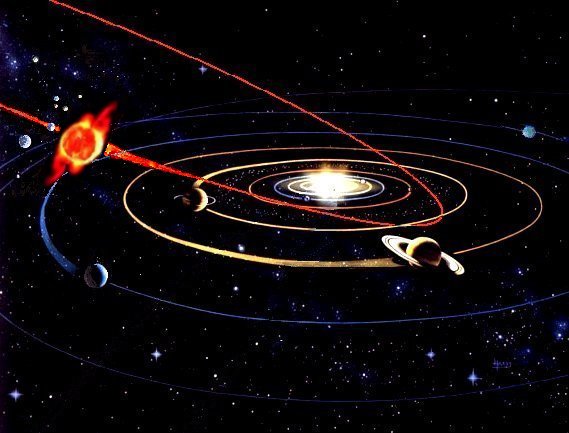
Here's a quote from Harold T. Wilkins that gives one pause for thought:
"In the ancient world, the priests and prophets had a saying: "As above so below. What has been shall be again".
"Censorinus, the Roman chronologist of the third century A.D. said that, at the end of every great year of six Babylonian sars (a period of 21,600 years), our planet undergoes a complete revolution. Polar and equatorial regions change place, the tropical vegetation and swarming animal life moving towards the forbidding wastes of the icy poles...
"Catastrophes attend the change, with great earthquakes and cosmical throes."" (9)
I'm tempted to say that Nibiru might have an orbit of about 6 Sars, which would be twice the size of Sedna's orbit of 3 Sars. As such, Nibiru's last perihelion passage would have been at the time of the last great cataclysm, probably 12,000 years ago or so. If its orbit is about 21,600 years then it is now past perihelion and on its way back towards the Sun. But its present distance from us would be much further than previously thought because a longer orbital period implies a much greater semi-major axis for the elliptical orbit.
It would be very interesting indeed if future discoveries of these strange extended scattered disc objects in our solar system showed a statistical correlation of their orbital periods. That their orbits were all related, with the Babylonian Sar being the basic numerical factor underpinning their relationship! From that we would be able to infer the existence of a distant massive perturbing planet in our solar system shepherding its widely dispersed flock of planetessimals.
So even if we have yet to 'see' Nibiru, we soon might be able to imply its existence from these companions.
Next Page: Nibiru: The Solution
Written by Andy Lloyd, 8th December 2004
author of 'The Dark Star' (2005), 'Ezekiel One' (2009), 'The Followers of Horus' (2010) and 'Darker Stars' (2019)
References
1) Maggie McKee "Stray Star may have jolted Sedna" 27th July 2004
2) A. Morbidelli & H. Levison "Scenarios for the origin of the Orbits of the Trans-Neptunian Objects 2000 CR105 and 2003 VB12 (Sedna)" Submitted to Astronomical Journal 2 April 2004
boulder.swri.edu/~hal/CR105.html
3) RedNova "Did our Sun capture alien worlds?" 2 Dec 2004, with thanks to Jeffrey Nolan and the lads from Cosmic Conspiracies' (article no longer available)
4) Z. Sitchin 'The Earth Chronicles Series' Avon/Bear & Co 1976-2002
5) V. Greffos “PLANETS – But How Many Are There In Our Solar System?” Science & Vie, Feb 2003
6) Z. Sitchin "The Case of the French Astronomer"
7) S. Ida, J. Larwood & A. Burkett “Evidence for Early Stellar Encounters in the Orbital Distribution of Edgeworth-Kuiper Belt Objects” The Astrophysical Journal, 528: pp351-6, (2000)
8) J. Kelly Beatty “Big-orbit Object Confounds Dynamicists” 5 April 2001 (article no longer available online)
9) Harold T. Wilkins "Mysteries of South America" p32 Rider & Co, London 1945
![]() Mysteries Of Ancient South America
Mysteries Of Ancient South America
For Morbidelli's latest theories, incorporating planetary migration in the early solar system, see:
10) M. Schirber "Fairy Tale' Might Explain Moon Craters and Planet Orbits" 25 May 2005, with thanks to Peter Gersten:


